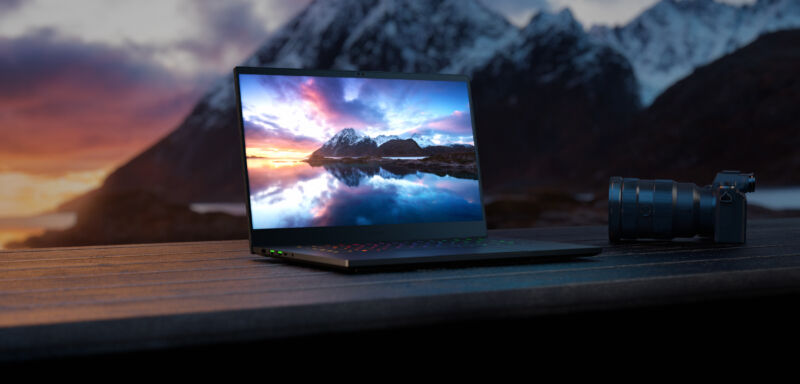

Razer’s 240 Hz laptop makes OLED more appealing to gamers
source link: https://arstechnica.com/gadgets/2022/05/razer-brings-240-hz-refresh-rate-to-oled-laptops/
Go to the source link to view the article. You can view the picture content, updated content and better typesetting reading experience. If the link is broken, please click the button below to view the snapshot at that time.

Contrast, meet speed —
Razer’s 240 Hz laptop makes OLED more appealing to gamers
Highly expensive PC's display balances speed, resolution, and contrast.
Scharon Harding - 5/4/2022, 5:21 PM

The portability of laptop displays means they often come with compromises in speed, color, or sharpness. For those who want a screen with the deepest contrast and darkest blacks without sacrificing speed, Razer is hoping to have the answer.
The upcoming configuration of the Razer Blade 15 announced Tuesday will be the first laptop to offer a 240 Hz refresh rate in an OLED panel. That makes OLED a more viable option for people, like gamers, who prioritize fast motion processing. Neither OLED monitors, with their high prices, nor OLED TVs have yet to reach such speeds. However, OLED has hit 240 Hz in other designs, such as in this camera's viewfinder.
The 15.6-inch screen on the upcoming Blade 15 claims a gray-to-gray (GtG) response time of 1 ms, which is as good as it gets for a gaming laptop these days, as well as 100 percent coverage of the wider DCI-P3 color space. As expected with an OLED panel, it's not super bright. At a claimed 400 nits, there are better laptop displays to use outside on a sunny day, for example.
To achieve its high refresh rate, the display is at 2560×1440 resolution, while you'll find many ultralight, non-gaming laptops offering OLED displays with 4K resolution. Razer makes a version of the Blade 15 with 4K OLED that's limited to a 60 Hz refresh rate for $200 cheaper as of this writing. However, 1440p has become a sweet spot for gamers seeking a sharper image without requiring as much graphics horsepower as 4K.
Beyond the panel, the Blade 15 has an RTX 3070 Ti laptop GPU, Intel Core i9-12900H, and up to 32GB of DDR5-4800 memory and a 1TB SSD, plus an empty M.2 slot. There's also good port selection with two USB-C ports, including one Thunderbolt 4, a USB-A port, an HDMI port, and an SD card reader.
AdvertisementRazer's announcement didn't make any battery-life claims about the OLED-equipped clamshell, but with OLED, a high refresh rate, and the machine's gaming heritage, don't expect longevity. The laptop does use Nvidia's Advanced Optimus feature that, among other things, switches between the discrete GPU and the processor's integrated graphics as necessary to conserve battery life.
When all is said and done, you're looking at a wildly expensive $3,500 machine when it comes out in Q4. "First" doesn't come cheap.
Razer's laptop should finally allow users to enjoy OLED's rich contrast, detailed shadows, and nuanced highlights without visual artifacts, like stuttering, deterring from the experience when your GPU is pushing high frame rates. Razer's Blade 15 laptops also come with G-Sync, Nvidia's Adaptive-Sync flavor, to fight screen tears. But if you want the smoothest video processing, laptops (including alternative configurations of the Razer Blade 15) that can hit 360 Hz and carry more powerful GPUs than Razer's upcoming speedy OLED system do exist.
In its announcement, Razer highlighted AAA games, which tend to boast impressive visuals, as a top use for the OLED panel. But unless it's a less graphically demanding esports game, you won't be pushing 240 frames per second to make the most of the screen's refresh rate, especially at 1440p resolution. If you're a gamer who plays a variety of genres, you'll more easily take advantage of the screen's multiple attributes.
Razer also pointed to photo and video editing and movie watching as good uses for the fast OLED display. But if OLED makes you envision turning the Blade 15 into an HDR vehicle, you might want to reconsider. The Blade 15 lacks VESA certifications for HDR image quality, DisplayHDR and DisplayHDR Tue Black for OLED, and doesn't highlight any HDR-focused features, like Dolby Vision support.
But if you want your SDR display to have some of the best contrast around while looking sharp during fast-paced action and supporting pretty high frame rates, Razer is finally making that an option.
Ars Technica may earn compensation for sales from links on this post through affiliate programs.
Recommend
About Joyk
Aggregate valuable and interesting links.
Joyk means Joy of geeK